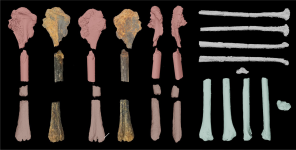Fred Ruhe
Well-known member

Chase Doran Brownstein, 2024
A juvenile bird with possible crown-group affinities from a dinosaur-rich Cretaceous ecosystem in North America
BMC Ecology and Evolution (2024) 24: 20

 doi.org
doi.org
Abstract and free pdf: A juvenile bird with possible crown-group affinities from a dinosaur-rich Cretaceous ecosystem in North America - BMC Ecology and Evolution
Background Living birds comprise the most speciose and anatomically diverse clade of flying vertebrates, but their poor early fossil record and the lack of resolution around the relationships of the major clades have greatly obscured
extant avian origins.
Results Here, I describe a Late Cretaceous bird from North America based on a fragmentary skeleton that includes cranial material and portions of the forelimb, hindlimb, and foot and is identified as a juvenile based on bone surface texture. Several features unite this specimen with crown Aves, but its juvenile status precludes the recognition of a distinct taxon. The North American provenance of the specimen supports a cosmopolitan distribution of early crown birds, clashes with the hypothesized southern hemisphere origins of living birds, and demonstrates that crown birds and their closest relatives coexisted with non-avian dinosaurs that independently converged on avian skeletal anatomy, such as the alvarezsaurids and dromaeosaurids.
Conclusions By revealing the ecological and biogeographic context of Cretaceous birds within or near the crown clade, the Lance Formation specimen provides new insights into the contingent nature of crown avian survival through the Cretaceous-Paleogene mass extinction and the subsequent origins of living bird diversity
Enjoy,
Fred
A juvenile bird with possible crown-group affinities from a dinosaur-rich Cretaceous ecosystem in North America
BMC Ecology and Evolution (2024) 24: 20

A juvenile bird with possible crown-group affinities from a dinosaur-rich Cretaceous ecosystem in North America - BMC Ecology and Evolution
Background Living birds comprise the most speciose and anatomically diverse clade of flying vertebrates, but their poor early fossil record and the lack of resolution around the relationships of the major clades have greatly obscured extant avian origins. Results Here, I describe a Late...
Abstract and free pdf: A juvenile bird with possible crown-group affinities from a dinosaur-rich Cretaceous ecosystem in North America - BMC Ecology and Evolution
Background Living birds comprise the most speciose and anatomically diverse clade of flying vertebrates, but their poor early fossil record and the lack of resolution around the relationships of the major clades have greatly obscured
extant avian origins.
Results Here, I describe a Late Cretaceous bird from North America based on a fragmentary skeleton that includes cranial material and portions of the forelimb, hindlimb, and foot and is identified as a juvenile based on bone surface texture. Several features unite this specimen with crown Aves, but its juvenile status precludes the recognition of a distinct taxon. The North American provenance of the specimen supports a cosmopolitan distribution of early crown birds, clashes with the hypothesized southern hemisphere origins of living birds, and demonstrates that crown birds and their closest relatives coexisted with non-avian dinosaurs that independently converged on avian skeletal anatomy, such as the alvarezsaurids and dromaeosaurids.
Conclusions By revealing the ecological and biogeographic context of Cretaceous birds within or near the crown clade, the Lance Formation specimen provides new insights into the contingent nature of crown avian survival through the Cretaceous-Paleogene mass extinction and the subsequent origins of living bird diversity
Enjoy,
Fred
Last edited:










